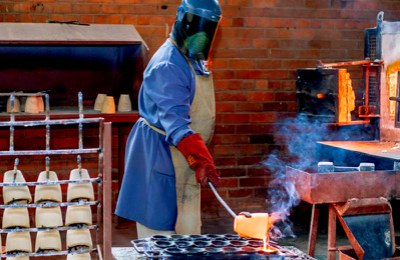Configuring Bika for Fire Assay
Background
Sans further sponsorship the preparation workflow became dormant though still lives in Bika fork for Bioinformatics, Baobab LIMS Fire AssayMetallurgists have used the Fire assay methods for thousands of years to extract precious metals from ores. It remains the same to this day and considered as the most accurate and reliable method for determining precious metal content in labs Samples are crushed, pulverised and weighed, then mixed with a lead based flux in a clay crucible and heated at high temperature in a furnace. Droplets of lead collect the precious metal as they descend through the sample After cooling down, the lead alloy button at the bottom of the crucible is cupellated, heated in a porous cup, and the lead and other impurities removed through oxidation, leaving a metallic bead The bead is dissolved, in aqua regia most often, and the precious metal concentrations determined by any of AAS, ICP-OES or ICP-MS
|
Preparation StepsThese are separated in the configuration by setting up the preparation steps in a Preparation Analysis Category with the highest sort order. This will see them always grouped together at the top of sample views and COAs Sorting these steps in order of execution in the Category gives users a quick overview of how far a sample has been processed Some preparation steps also have measurements captured like weights and % and particle size distributions Analysis Specifications can be applied, and e.g. a sample too coarse will be reflected as Out of Range Preparations that require no measurements are configured with a Results Option of ‘Completed’ or ‘Done’ which the user toggles when the step is completed - the date time and username are captured Samples for a specific preparation step can also be grouped together on Worksheets for ease of management, say Crushing or Firing a group of samples Analysis. Keywords
The result for the same analyte thus, say Au, can be achieved using different methods and are best managed in separate Analysis Services (ASs). They might also differ in price, unit, instrument used etc. ASs are uniquely identified by instrument importers using their unique keywords, e.g. the wavelength used by the instrument in its results export, Au24280 for Au, and multiple instruments often use the same This can be resolved in the LIMS through AS keywords that include the AS’ method to differentiate between them, e.g. Au24280_GFAAS, Au24280_ICPMS, Au24280_XRF Going out from the assumption that the same element will not be requested more than once per Sample, the importers are coded to find the AS on its keyword’s leading characters only, here Au24280 In the rare case that more than one Au24280* Analyses are found, nothing should be imported and the analyst alerted to the duplicate. Labs soon learn to do these tests on two different sample partitions
|
ConfigurationConfiguring this number of Analyses in the LIMS is hazardous - imagine the full table of elements analysed in a few different ways, using fire assay, aqua regia or gravimetric methods, and analysed on flame or graphite furnace AAS, ICP-MS, ICP-OES or XRF instruments At sample registration time these can thankfully be managed using Analysis Profiles for the tests frequently ordered together, and on Worksheets with templates preconfigured for instrument trays, including QC samples Using the latest setup data upload formats and code, goes a long way and getting out of the blocks is achieved a lot quicker than with traditional LIMS. It is important to get these absolutely right, else all of the ASs will have to be edited manually (or scripted for) ConclusionCoded workflow enforcements - sequential state changes for samples in preparation and restrictions on further actions available per state - will improve on the above configuration based solution, testament to Bika’s flexibility But for analysing ores no? Analysts physically cannot analyse raw samples. In other labs with less tangible Sample material, e.g tubes of clear liquid in different preparation states, it is well required for easier management Bika inherits Plone’s role based workflow engine which can already be manipulated in the system’s management interface. Surfacing this configuration in a more friendly coded way is well within reach where needed and budget allows. And that does not have to be much
|






